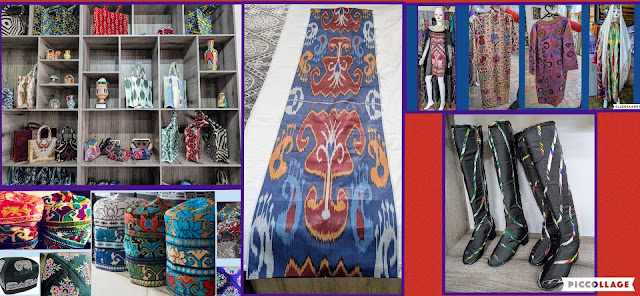For the one-hour train ride from Andijon to Margilon we are in a four person coach and thankful that there are only two of us in it.
Staff on the train are careful to make sure they know where you are going and to give you a heads up when your stop is next, which we greatly appreciate.
We go to this one first, as it is the one we most often see in the 'what to do in Margilon' information, followed by what is simply called Silk Factory
We just drop in to both factories, no reservations. At Yodgorlik, a young woman greets us in excellent English. She tells us that the factory is spread throughout several buildings and that we are welcome to go into any building where the door is open, and that the staff in each building will welcome us. They do.
The last building is the gift shop, which we are encouraged to check out. She will collect 15,000 som from us for our self-tour when we are ready to leave.
In the Silk Factory, a young lad of about 14 or 15 years greets us, also in excellent English. He is to be our guide and is so excited to be showing us around that he speaks very fast and has to slow himself down.
He first tells us that this is a family-owned fourth-generation factory. Here, there is no fee for the tour and the men put on a fabric dying workshop. At the end of the workshop, we are lead to their commercial outlet where the array of silk and/or silk + cotton products is quite large.
There were so many beautiful products, it would be hard to name them all. Coming home is a table runner, a jacket for Linda, and a new hat for Paul.
Another woman and I are trying on jackets at the same time. She's the first English-speaking tourist we've met since our arrival a week ago. She's a bit younger than us (from Germany), on her own, and backpacking around for five months. We ran into her a couple more times, including at the train station to leave Margilon.
The collage below gives you an idea of what is produced. The runner in the center comes home with me.
Many of the clothes are illustrated with representations of the pomegranate, which grows here and is a favourite fruit and fruit drink. It's also loved for the beauty of its shrub, flowers and fruit. It has taken many symbolic meanings over the years, including: strong union, friendship, fertility, sanctity and abundance.
I have always loved the Ikat work and was lucky enough to find a reversible jacket that has Ikat on one side and pomegranates on the other side.At Yodgorlick, most buildings have been painted with some aspect of the silk industry, so we have a look at these first.

These cocoons consist of a single continuous silk thread that can reach up to one thousand meters long. We are gifted with our own cocoons.
The cocoons are then soaked in hot water to soften the sericin (binding protein) and unwound. Multiple cocoon filaments are combined and twisted together to create silk thread. Once the cocoon is all unwound, there remains the creature that was inside. Apparently, birds love them, and the Silk Factory has a big cage with some budgies that are fat and full.
In the collage below is the woman at Yodgorlik who showed us around. She has been soaking her cocoons, and if you look carefully at the top right photo, you will see how very fine the filaments are. Then we sit at the wheel where she begins to spin the filaments. There is a bit of an odour from the soaking cocoons, but it's rather pleasant.
This lovely worker then takes the time to serve us tea. Before leaving, she wraps my wrist with a strand of twisted silk threads.
The 'sampler' below shows different colours that are dyed and some of the different sizes of the spun and twisted silk thread.
Below, women from the silk factory are spinning silk on a wheel and have samples of different threads. Pulling on a silk thread shows its great strength,
The thread is then dyed.
At the Silk Factory, our young guide shows us pots of dried flowers, herbs, leaves and twigs that are soaked and used to create the natural dyes (bottom left in collage below).
Then men from the factory sit down with the eight or so of us that happened to be here, to show us how to make dye, twist the silk to get different patterns, then dip it. Their newly made, wet scarves hang on the line and will be sold in the store.
The next day, our last, we had planned to take a shared taxi to either the city of Fergana (capital city of the Fergana Valley) or to Rishton to the ceramic factory., each one a half hour drive away. We have seen so many bloggers say the only time they have been terrified is on the roads of Uzbekistan. It's true, we can see it as even city roads are used as racetracks. This is not just our impression, as the number of road accidents and fatalities in Uzbekistan is more than forty-five percent above the EU average.
A few photos from along the route. We also see shepherds and their sheep, donkeys, half a dozen stork nests all occupied, but we are too slow with the camera. The water you see is dammed for power.









































No comments:
Post a Comment